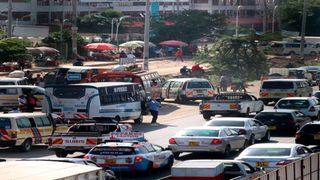
Traffic in Nairobi.
| Diana Ngila | Nation Media GroupNairobi
Premium
Why Nairobi might be uninhabitable in the next 50 years
Just before the Uganda railway line cut through Nairobi at the turn of the 20th century, the area was virtually desolate.
In the 1800s, the only human presence in the savannah was the Maasai pastoralists. Forage in this wilderness was plenty, water from its rivers and swamps cool. Herbivores and hunters roamed the expanse of the county that constituted mainly bushland and scattered forests.
At the time, the area between Rongai and Kiserian was an active migratory corridor for elephants, buffaloes, zebras and gazelle species. The wild animals moved from one part of today’s Kajiado to the other in search of grazing and mating fields. Lions, leopards and other predators would be in tow, killing some of the grazers for food. It was nature at its most tranquil.
Then came the so-called Lunatic Express and the matrix of life here changed. Soon, the savannah sprawl gave way to a concrete city. Where bushland thrived, apartment buildings, roads and other infrastructure took over.
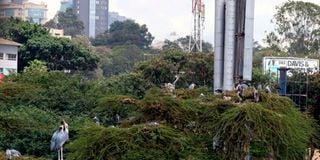
The marabou stork perched on tree tops along Uhuru Highway in Nairobi.
Wiped out
In just 100 years, Nairobi has overrun its ecology — shut wildlife corridors forever, driven its animals away and wiped out forests.
Nairobi is hardly the green city in the sun anymore. Only a smattering of greenery has survived, often in places that cannot support development, or in protected areas and private land.
At slightly more than 120 years, Nairobi is nowhere close to the league of its oldest continental peers. Compared with Old Cairo (100 AD), Kismayo (300 AD) and Lagos (1500s), Kenya’s capital is a teenager.
Yet the city is already reeling from the effects of an exponential if unsustainable growth, the carnage of its natural environment and a raging climate change. At this rate, Nairobi might just be uninhabitable in 50 years, experts warn.
But where did the city miss the mark? And are the effects reversible?
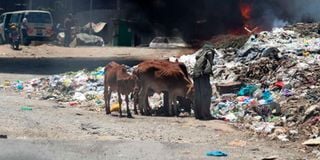
Cows feeding from garbage dumped on the roadside in Mukuru Kayaba slums in Nairobi.
Trees gone
For many years, driving along Uhuru Highway was a delight. With tree-lined sides and the annual bloom of white, pink and purple, the city’s vista was a spectacle. With most of the trees now gone to pave the way for infrastructure, notably the Nairobi Expressway, the stretch now resembles a rugged scalp whose hair was shorn with no care for the method.
Some of the trees that were mowed down recently were several generations old, some as old as the city itself.
Various statistics paint a frightful picture, for in the only 24 years between 1976 and 2000, Nairobi lost its forest cover by 11 per cent to the current three per cent.
During this period, bushland cover was not spared either, having been cleared from 22 per cent to 13 per cent. With heightened development in the last 20 years, what remained then has been whittled down even further.
But it is the carnage of the city’s greenery for the past 10 months that struck a raw nerve among city residents. Environmental activists hit the roof. The flak, though, neither stopped the excavators nor slowed down the contactors. Soon, the noise died out. The city moved on. Until the next destruction.
Windows drawn
Stella Mulinge constantly wipes sweat off her face as she navigates Monrovia Street in the central business district. It’s only 9am, but her body is clammy with sweat.
“I always have an extra top. One just can’t work,” she says casually.
At the parking lot of Ambank House where she works, Mulinge stays put after killing the engine, windows drawn, to cool off before heading out to her office.
‘’It has become warmer in the city over the years. It wasn’t always like this,” she observes, without agonising over the details of what could be driving the city’s temperatures up.
For those using public transport, the agony is twofold. When stuck in congestion, passengers often have to choose between boiling in the heat or opening windows and risking losing their valuables to muggers who target vehicles in traffic snarl-ups.
‘’If closer to town, I prefer to disembark and walk the rest of the journey to sitting and sweating in the stationary vehicle,’’ says Alex Nduati, a cleaner in the city.
Urban heat island
This micro-climate is called urban heat island, where temperatures in the city are higher than in surrounding areas that have a vegetative cover. It occurs when impervious surfaces such as concrete, tarmac and metal absorb more solar radiation than they can reflect, argues Victor Ongoma, an expert in physical geography.
Leaving the city centre is a relief for most city residents. The air becomes fresher, the weather cooler.
“After Allsops, I close the windows for the rest of the journey to Ruiru,’’ says Mulinge.
On most afternoons when the sun’s heat is sweltering, it’s common to find families sitting outside their shacks in the city slums of Kibera and Mathare, even as they should be sheltering indoors. But made of tin and poorly ventilated as the cottages are, staying indoors is suicidal.
“It’s much cooler outside than inside the house,” explains Teresa, a resident of Lindi in Kibera.
Teresa and her neighbours may escape the sun’s brutality during the daytime, but at night, they bear its full effects.
“The effect (of urban heat island) is more pronounced at night when [most] impervious surfaces re-radiate into the atmosphere the heat absorbed during the day,” explains Ongoma, who’s an assistant professor at Mohammed VI Polytechnic University in Morocco.
The urban heat island effect is a health risk too, said to aggravate pre-existing conditions such as heart and lung diseases, asthma, diabetes and kidney failure.
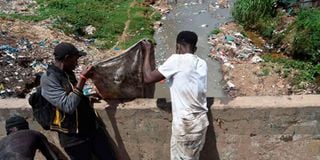
Men throwing garbage into Nairobi River.
Too polluted
The destruction of the city’s ecosystem has not spared its water sources either. During pre-colonial times, water in Nairobi, Ngong, Mathare and Ruaraka rivers was cool and clean. All changed upon human settlement when Nairobi became a railway town in the early 1900s.
For 100 years, industrial effluent, farm chemicals and domestic waste have choked Nairobi’s rivers. A lack of proper waste management, invasion of riverine land for settlement and unregulated farming activities upstream are to blame for the mess.
Too little and too polluted for domestic use, water from Nairobi rivers falls short of the city’s 810 million litres daily demand. Neighbouring counties of Murang’a and Kiambu are the soul of the city.
Underground water in Nairobi too is neither sustainable nor entirely safe for use. External pollutants have been discovered in borehole water in the city in recent years, according to Michael Thuita, CEO of Athi Water Works Development Agency.
To restore city rivers, the government has in the past year intensified clean-up activities through the Nairobi City Regeneration Programme. Part of these efforts includes laying new sanitation infrastructure and rehabilitating the older ones to prevent sewage spillage into rivers.
Hands down, Kenya’s capital is one of the fastest-growing cities in the world. Technological evolution, state-of-the-art infrastructure, and an educated middle-class are at the heart the Nairobi’s blistering growth into a global metropolis.
Worst place to live
Yet measured against World Bank indicators of the quality of life namely quality of air and access to clean water, shelter and security, the city must be the worst place to live in Kenya. Other parameters of quality of life are employment, environment and natural hazards. In these areas, Nairobi’s score has been at best dreary, at worst uninspiring.
Foremost, more than 60 per cent of Nairobi residents live in informal settlements. A 2005 report by UN-Habitat showed that 75 per cent of Nairobi’s growing population was being absorbed by low-scale neighbourhoods.
The report, Nairobi Urban Sector Profile, estimated that more than half of the city’s population would be living in slums and other informal settlements by 2021. Interestingly, these settlements account for only five per cent of Nairobi’s total residential land area.
Poorest families
Kibra Constituency, for instance, has 170,000 residents, according to the 2019 National Housing and Population Census report. These live within an area of 2.5km², translating to a population density of 68,000 people per square kilometre. This is 715 times higher than Kenya’s average population density of 95 people per square kilometre.
Second, the city’s poorest families, most without proper sanitation facilities and live on less than Sh100 a day, are at the most risk of environmental disasters.
When flash floods hit Nairobi last week, the Kibera slum incurred the heaviest loss, with four people reported dead, tens of households displaced and property worth millions swept away.
In Nairobi’s concoction of woes, haphazard planning has played a major role. Since colonial times, the Kilimani, Muthaiga, Kileleshwa and Parklands neighbourhoods were reserved for residential purposes. A stroll in these vicinities today turns up an interesting finding — mixed-use.
With office blocks competing for the skyline in these sections of the city, it is hard to tell anymore whether these neighbourhoods are commercial or residential.
In urban design, zoning stipulates the usage of land in different segments of a town or city. Change of land use policy or violation of existing zoning laws over the years have piled pressure on the city’s land.
With the demand for office space rising, former residential areas are fast falling into commercial use, according to Patricia Mwangi, a tutorial fellow at the Department of Spatial Planning and Urban Management at Kenyatta University.
Predictably, green spaces have been the first casualty as the zones fast turn into a jumble of concrete edifices, clatter and confusion. Often, residents’ uproar is drowned in the din of fast-paced development.
It could get worse. Picture this: A marabou stork stabs a polythene bag at an illegal dumpsite at Clay City in Kasarani, tearing out a used condom and diapers before feasting greedily on what looks like a piece of rotten raw chicken. It’s an ugly spectacle to behold. Yet not half as perilous as the potential health and social risks that the scavengers pose to residents of this relatively populous estate.
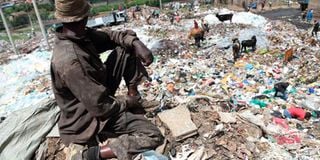
People and animals scavenge for valuables and food at the Dandora dumpsite in Nairobi.
Competition for crumbs
At Dandora dumpsite, human and bird scavengers pore through towers of trash all day in a classic competition for crumbs between humans and wildlife.
The birds’ invasion first became a concern about 10 years ago. At the time, they nestled among trees at Nyayo Stadium and Harry Thuku Road. Today, they have infested the entire city with their sheer numbers.
In 2009, Kenya Wildlife Services (KWS) asked residents to learn to live with the scavengers following an outcry even as the National Environment Management Authority put their relocation down to “underlying environmental changes”.
Alfred Owino, a bird expert at the KWS, argued that emerging settlements around the birds’ natural nesting places had displaced them, forcing them to nest in the few remaining patches of forests.
Owino said there were no “quick fixes” to the marabou menace. Ten years later, none seem to have been found as the scavenger numbers hit alarming levels.
Infectious diseases
The loss of green spaces in a locale disrupts the biodiversity balance by displacing native wildlife such as fruit bats, primates and pollinators that help to maintain this balance, according to Eric Fèvre, a professor of veterinary infectious diseases at the University of Liverpool.
Says Fèvre: “Consequently, wildlife species that co-exist with humans [among them] rats, scavenging and seed-eating birds thrive, particularly in the poorer, most densely populated areas.”
Collectively called synanthropes, these animal species host more germs that cause zoonotic diseases, ranging from mild forms to deadlier ones such as Covid-19.
Designated a zoonotic disease by the World Health Organisation, Covid-19 has ravaged humanity globally, infecting 164 million and killing 3.5 million others.
In some informal settlements, humans interact freely with marabou storks and other scavengers owing to uncollected garbage.
In the event of a full-blown explosion of a bird, virus experts warn that these estates would suffer the worst devastation.





